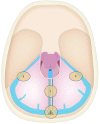Tentorial dural fistulas: endovascular management and description of the medial dural-tentorial branch of the superior cerebellar artery
- PMID: 23660293
- PMCID: PMC7965633
- DOI: 10.3174/ajnr.A3519
Tentorial dural fistulas: endovascular management and description of the medial dural-tentorial branch of the superior cerebellar artery
Abstract
Background and purpose: TDAVFs are uncommon causes of spontaneous intracranial hemorrhage. A retrospective review of their management was performed after repeatedly observing a previously under-recognized medial dural-tentorial branch of the SCA.
Materials and methods: Thirteen patients were diagnosed with TDAVFs by CT/MR imaging and DSA during a 5.8-year period. Seven patients presented after intracranial hemorrhage. Twelve patients were treated endovascularly, and one, surgically.
Results: Eleven TDAVFs were located in the midline (7 at the falx cerebelli and 4 at the torcular), and 2 were petrotentorial. All torcular TDAVFs were associated with sinus thrombosis and showed bidirectional drainage relative to the tentorium. No sinus thrombosis was seen in the falx cerebelli subtype, which drained infratentorially only, except in 1 patient who had had unrelated surgery previously. Venous drainage was directly to cortical veins except for 1 petrotentorial and 2 torcular TDAVFs. A branch of the SCA, the medial dural-tentorial artery, was observed in 5 midline TDAVFs. Its anatomy was defined with selective angiography. Endovascular therapy resulted in a cure in 5 and subtotal occlusion in 6, and staged treatment is ongoing in 1 patient. One patient was cured after surgery.
Conclusions: TDAVFs frequently cause intracranial hemorrhage and therefore warrant treatment. Endovascular therapy proved effective in this series, and arteriography was essential for understanding the various fistula subtypes and for treatment planning. We emphasize the importance of recognizing the medial dural-tentorial artery of the SCA with its characteristic course along the tentorium on angiography. This artery should be included in future anatomic descriptions of the cranial blood supply.
Figures





Similar articles
-
Bilateral Thalamic Edema Caused by Tentorial Galenic Dural Arteriovenous Fistula and Sinus Thrombosis: Successful Endovascular Therapy.Turk Neurosurg. 2025;35(4):667-671. doi: 10.5137/1019-5149.JTN.47423-24.1. Turk Neurosurg. 2025. PMID: 40577497
-
Tentorial dural arteriovenous fistulas.Surg Neurol. 2007 May;67(5):472-81; discussion 481-2. doi: 10.1016/j.surneu.2006.08.078. Surg Neurol. 2007. PMID: 17445607
-
Microsurgical treatment of a tentorial galenic dural arteriovenous fistula.Neurosurg Focus. 2016 Jan;40 Video Suppl 1:2016.1.FocusVid.15420. doi: 10.3171/2016.1.FocusVid.15420. Neurosurg Focus. 2016. PMID: 26722680
-
Medial Tentorial Dural Arteriovenous Fistula Embolization: Single Experience with Embolic Liquid Polymer SQUID and Review of the Literature.World Neurosurg. 2017 Nov;107:1050.e1-1050.e7. doi: 10.1016/j.wneu.2017.08.050. Epub 2017 Aug 18. World Neurosurg. 2017. PMID: 28826865 Review.
-
Intracranial hemorrhage from dural arteriovenous fistulas: clinical features and outcome.Neurosurg Focus. 2013 May;34(5):E15. doi: 10.3171/2013.4.FOCUS1335. Neurosurg Focus. 2013. PMID: 23634919 Review.
Cited by
-
Management of Petrous and Tentorial Dural Arteriovenous Fistulas: A Systematic Review.Cureus. 2024 Nov 14;16(11):e73701. doi: 10.7759/cureus.73701. eCollection 2024 Nov. Cureus. 2024. PMID: 39677177 Free PMC article. Review.
-
Spontaneous resolution of a tentorial dural arteriovenous fistula fed by the artery of Wollschlaeger and Wollschlaeger after embolization of the main shunting point.Surg Neurol Int. 2021 Aug 16;12:413. doi: 10.25259/SNI_610_2021. eCollection 2021. Surg Neurol Int. 2021. PMID: 34513177 Free PMC article.
-
Artery of Davidoff and Schechter: A Large Angiographic Case Series of Dural AV Fistulas.Neurohospitalist. 2022 Jan;12(1):155-161. doi: 10.1177/19418744211022217. Epub 2021 Jun 15. Neurohospitalist. 2022. PMID: 34950406 Free PMC article.
-
Normal pio-dural arterial connections.Interv Neuroradiol. 2015 Dec;21(6):750-8. doi: 10.1177/1591019915609137. Epub 2015 Oct 22. Interv Neuroradiol. 2015. PMID: 26494407 Free PMC article.
-
Posterior Fossa Dural Arteriovenous Fistulas with Subarachnoid Venous Drainage: Outcomes of Endovascular Treatment.AJNR Am J Neuroradiol. 2019 Aug;40(8):1363-1368. doi: 10.3174/ajnr.A6140. Epub 2019 Aug 1. AJNR Am J Neuroradiol. 2019. PMID: 31371356 Free PMC article.
References
-
- Kajita Y, Miyachi S, Wakabayashi T, et al. . A dural arteriovenous fistula of the tentorium successfully treated by intravascular embolization. Surg Neurol 1999;52:294–98 - PubMed
-
- Zhou LF, Chen L, Song DL, et al. . Tentorial dural arteriovenous fistulas. Surg Neurol 2007;67:472–81 - PubMed
-
- van Lindert E, Hassler W, Kühne D, et al. . Combined endovascular-microsurgical treatment of tentorial-incisural dural arteriovenous malformations: report of five cases. Minim Invasive Neurosurg 2000;43:138–43 - PubMed
-
- Picard L, Bracard S, Islak C, et al. . Dural fistulae of the tentorium cerebelli: radioanatomical, clinical and therapeutic considerations. J Neuroradiol 1990;17:161–81 - PubMed
MeSH terms
LinkOut - more resources
Full Text Sources
Other Literature Sources
